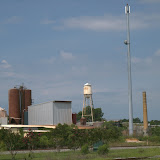Then we drove the last mile to the Tift Theatre. This is a fine 1930s art deco style cinema that despite all the odds has survived. Curiously, it uses the European spelling of theatre rather than "theater". Fortunately over the years the interior was covered with heavy drapes and so all the original details survived. Once the drapes were removed the bright design was revealed, bold colours and shapes borrowed from the circus. The exterior is brilliantly restored too and the animated neon marquee and bright sign boards are splendid. A very far cry from the mundane "Cinema 6" at the Tifton Mall.
Inside you can imagine that you have gone back to 1937. If I was a location manager who needed a period movie theatre this would be ideal. We were shown around by Mack Freeman who was setting up for the night's show. The stage was set as a cafe for the first of three one act plays.
The audience sits on metal framed tip-up seats with deep upholstery. The tipping is controlled by metal springs that creak and twang. Looking up you'll see that the projection window is empty. Instead there is a small data projector suspended halfway down the room that looks a bit feeble for that space.
That night we hurried our Krystals and arrived at the theatre with the marquee sparkling and announcing "Three One Act Plays". We were only just in time. The auditorium was completely dark as the lights had been turned off at the start. We made our way near the front and groped our way into the creaking seats. The lights came up and we found ourselves in in a largely empty theatre. John Tibbetts powerfully projected his voice in the way of actors, and this fitted the part well as he was playing God. I didn't understand a word of Roslon's Southern accent but I was probably the only one as everyone else in the audience was local.
The scenery ingeniously used the same brick wall prop for all three plays. In the interval we went and bought candy at the entrance desk and they asked us who we were connected to. Everybody else in the audience were friends and relatives of cast and crew. We had no such connection and we were there because I wanted to experience the theatre. The plays were certainly no Broadway hits and were more like school plays but they were charmingly performed.
You could imagine the cinema a couple of years after opening. Every seat filled, and the first reel of "Gone With the Wind" started. The crackly sound coming through and the projectionist cranking the focus to get the picture as sharp as possible.
Afterwards Tammy took some night pictures and the cars parked in front of the Tift Theatre went one by one as the cast went home.
 |
| Click here for Tammy's Pictures |
